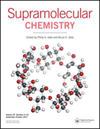A novel thiosemicarbazide based chemosensor for colorimetric detection of Co2+ in commercial B12 vitamin and Co2+, Ni2+ simultaneously in aqueous media
IF 2.6
4区 化学
Q3 CHEMISTRY, MULTIDISCIPLINARY
引用次数: 5
Abstract
ABSTRACT In this study, a novel thiosemicarbazide-based Schiff-base chemosensor containing naphthalene moiety (TSNCS) was easily synthesised and used for colorimetric detection of Ni2+, Co2+ ions in real samples. Probe TSNCS displayed an obvious colour change from colourless to dark yellow in the presence of Co2+ and Ni2+ in aqueous acetonitrile solutions. The interaction-binding mode of probe TSNCS with Co2+ (TSNCS-Co2+) and Ni2+ (TSNCS-Ni2+) was found to be 1:1 based on Job’s plot analysis. The results showed that the chemosensor TSNCS could provide a rapid analytical method for naked-eye detection of Co2+ and Ni2+ with detection limits (LOD) of 0.0114 μM and 0.0168 μM, respectively. Furthermore, the TSNCS-based test papers strips were successfully used for the rapid detection of Co2+ and Ni2+ ions in an aqueous solution. In addition, probe TSNCS was applied for the qualitative and quantitative analysis of Co2+ in the commercial vitamin B12 and real water samples. GRAPHICAL ABSTRACT一种新型硫脲基化学传感器,可同时比色检测商业维生素B12中的Co2+和水介质中的Co2+、Ni2+
摘要:本文合成了一种新型的含萘基团硫脲基席夫碱化学传感器(TSNCS),并将其用于实际样品中Ni2+、Co2+离子的比色检测。探针TSNCS在乙腈水溶液中,在Co2+和Ni2+存在下,呈现由无色到深黄色的明显变色。通过Job’s plot分析发现探针TSNCS与Co2+ (TSNCS-Co2+)和Ni2+ (TSNCS-Ni2+)的相互作用结合模式为1:1。结果表明,化学传感器TSNCS可提供一种快速的裸眼检测Co2+和Ni2+的方法,检出限(LOD)分别为0.0114 μM和0.0168 μM。此外,还成功地将基于tsncs的试纸条用于水溶液中Co2+和Ni2+离子的快速检测。此外,还应用探针TSNCS对商业维生素B12和实际水样中的Co2+进行了定性和定量分析。图形抽象
本文章由计算机程序翻译,如有差异,请以英文原文为准。
求助全文
约1分钟内获得全文
求助全文
来源期刊

Supramolecular Chemistry
化学-化学综合
CiteScore
3.60
自引率
3.00%
发文量
5
审稿时长
2.7 months
期刊介绍:
Supramolecular Chemistry welcomes manuscripts from the fields and sub-disciplines related to supramolecular chemistry and non-covalent interactions. From host-guest chemistry, self-assembly and systems chemistry, through materials chemistry and biochemical systems, we interpret supramolecular chemistry in the broadest possible sense. Interdisciplinary manuscripts are particularly encouraged. Manuscript types include: high priority communications; full papers; reviews, and; Methods papers, techniques tutorials highlighting procedures and technologies that are important to the field. We aim to publish papers in a timely fashion and as soon as a paper has been accepted and typeset it will be published in electronic form on the Latest articles section of the website. The two most important review criteria are that the paper presents high-quality work that fits generally into the broad spectrum of activities in the supramolecular chemistry field. Under normal circumstances, Supramolecular Chemistry does not consider manuscripts that would be more suitable in a highly specialized journal. This includes, but is not limited to, those based mostly or exclusively on topics such as solid state/X-ray structures, computational chemistry, or electrochemistry. .
The two most important review criteria are that the paper presents high-quality work that fits generally into the broad spectrum of activities in the supramolecular chemistry field.
 求助内容:
求助内容: 应助结果提醒方式:
应助结果提醒方式:


